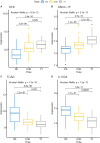Identification of Post-myocardial Infarction Blood Expression Signatures Using Multiple Feature Selection Strategies
- PMID: 32581823
- PMCID: PMC7287215
- DOI: 10.3389/fphys.2020.00483
Identification of Post-myocardial Infarction Blood Expression Signatures Using Multiple Feature Selection Strategies
Abstract
Myocardial infarction (MI) is a type of serious heart attack in which the blood flow to the heart is suddenly interrupted, resulting in injury to the heart muscles due to a lack of oxygen supply. Although clinical diagnosis methods can be used to identify the occurrence of MI, using the changes of molecular markers or characteristic molecules in blood to characterize the early phase and later trend of MI will help us choose a more reasonable treatment plan. Previously, comparative transcriptome studies focused on finding differentially expressed genes between MI patients and healthy people. However, signature molecules altered in different phases of MI have not been well excavated. We developed a set of computational approaches integrating multiple machine learning algorithms, including Monte Carlo feature selection (MCFS), incremental feature selection (IFS), and support vector machine (SVM), to identify gene expression characteristics on different phases of MI. 134 genes were determined to serve as features for building optimal SVM classifiers to distinguish acute MI and post-MI. Subsequently, functional enrichment analyses followed by protein-protein interaction analysis on 134 genes identified several hub genes (IL1R1, TLR2, and TLR4) associated with progression of MI, which can be used as new diagnostic molecules for MI.
Keywords: Monte Carlo feature selection; gene; incremental feature selection; myocardial infarction; support vector machine.
Copyright © 2020 Li, Chen, Zhang, Xiong, Li and Huang.
Figures




Similar articles
-
Identification of hub biomarkers of myocardial infarction by single-cell sequencing, bioinformatics, and machine learning.Front Cardiovasc Med. 2022 Jul 25;9:939972. doi: 10.3389/fcvm.2022.939972. eCollection 2022. Front Cardiovasc Med. 2022. PMID: 35958412 Free PMC article.
-
Identification of leukemia stem cell expression signatures through Monte Carlo feature selection strategy and support vector machine.Cancer Gene Ther. 2020 Feb;27(1-2):56-69. doi: 10.1038/s41417-019-0105-y. Epub 2019 May 29. Cancer Gene Ther. 2020. PMID: 31138902
-
Potential role of a three-gene signature in predicting diagnosis in patients with myocardial infarction.Bioengineered. 2021 Dec;12(1):2734-2749. doi: 10.1080/21655979.2021.1938498. Bioengineered. 2021. PMID: 34130601 Free PMC article.
-
Identification of gene expression profiles in myocardial infarction: a systematic review and meta-analysis.BMC Med Genomics. 2018 Nov 27;11(1):109. doi: 10.1186/s12920-018-0427-x. BMC Med Genomics. 2018. PMID: 30482209 Free PMC article.
-
Clinical aspects of left ventricular diastolic function assessed by Doppler echocardiography following acute myocardial infarction.Dan Med Bull. 2001 Nov;48(4):199-210. Dan Med Bull. 2001. PMID: 11767125 Review.
Cited by
-
Screening for Core Genes Related to Pathogenesis of Alzheimer's Disease.Front Cell Dev Biol. 2021 Apr 22;9:668738. doi: 10.3389/fcell.2021.668738. eCollection 2021. Front Cell Dev Biol. 2021. PMID: 33968940 Free PMC article.
-
Transcriptional profiling unveils molecular subgroups of adaptive and maladaptive right ventricular remodeling in pulmonary hypertension.Nat Cardiovasc Res. 2023 Oct;2(10):917-936. doi: 10.1038/s44161-023-00338-3. Epub 2023 Sep 28. Nat Cardiovasc Res. 2023. PMID: 39196250 Free PMC article.
-
LncRNA HIF1A-AS2: a potential biomarker for early diagnosis of acute myocardial infarction and predictor of left ventricular dysfunction.BMC Cardiovasc Disord. 2023 Mar 14;23(1):135. doi: 10.1186/s12872-023-03164-4. BMC Cardiovasc Disord. 2023. PMID: 36918770 Free PMC article.
-
Mitigation of Doxorubicin Cardiotoxicity With Synergistic miRNA Combinations Identified Using Combinatorial Genetics en masse (CombiGEM).JACC CardioOncol. 2025 Jun;7(4):396-410. doi: 10.1016/j.jaccao.2025.03.007. Epub 2025 May 13. JACC CardioOncol. 2025. PMID: 40366325 Free PMC article.
-
Identification of lipid metabolism-related genes in myocardial infarction: implications for diagnosis and therapy.J Cardiothorac Surg. 2025 Jul 9;20(1):289. doi: 10.1186/s13019-025-03525-4. J Cardiothorac Surg. 2025. PMID: 40635026 Free PMC article.
References
-
- Balbay Y., Tikiz H., Baptiste R., Ayaz S., Şaşmaz H., Korkmaz ŞJ. A. (2001). Circulating interleukin-1 beta, interleukin-6, tumor necrosis factor-alpha, and soluble ICAM-1 in patients with chronic stable angina and myocardial infarction. Angiology 52 109–114. 10.1177/000331970105200204 - DOI - PubMed
-
- Bax J. J., Baumgartner H., Ceconi C., Dean V., Fagard R., Funck-Brentano C., et al. (2012). Third universal definition of myocardial infarction. Eur. Heart J. 60:1581. - PubMed
LinkOut - more resources
Full Text Sources

